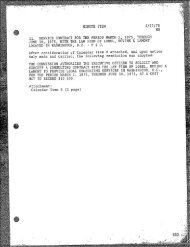Mooring Loads Due to Parallel Passing Ships - State Lands ...
Mooring Loads Due to Parallel Passing Ships - State Lands ...
Mooring Loads Due to Parallel Passing Ships - State Lands ...
You also want an ePaper? Increase the reach of your titles
YUMPU automatically turns print PDFs into web optimized ePapers that Google loves.
With the above coefficients, peak loads may be predicted from equation (1) as:<br />
1 2<br />
FX− = ρ DLV C<br />
2<br />
X−<br />
1 2<br />
FY+ = ρ DLV C<br />
2<br />
Y+<br />
1 2 2<br />
M− = ρ DL V C<br />
2<br />
M −<br />
As illustrated in Figure 14, these are the peak loads, in the positive direction for<br />
FY, and in the negative direction for FX and M. The secondary maxima in the opposite<br />
direction can be estimated as<br />
FX+ = 085 . FX−<br />
FY− = 061 . FY+<br />
M+ = 091 . M−<br />
These are based on the average relationship between the positive and negative<br />
force maxima from the lab tests. As illustrated in Figure 12, the theoretical results of<br />
Wang suggest that FX and M should be larger than indicated with the same magnitude<br />
in the positive and negative direction, while the negative sway force should be a little<br />
smaller than indicated or about 0.46 FY+.<br />
Peak loads predicted using equations (2) and (3) have been compared <strong>to</strong><br />
measured coefficients from Table 5, with results plotted in Figure 18. In each part of<br />
the figure, measured and predicted loads are compared <strong>to</strong> a line of perfect agreement.<br />
While the empirical model is developed <strong>to</strong> give no bias <strong>to</strong>ward over or under predicting<br />
the peak loads, some scatter is apparent. This is due <strong>to</strong> inherent variability in the<br />
experiments and due <strong>to</strong> the simplified nature of the empirical model. Maximum error is<br />
on the order of ± 25% with typical error on the order of ± 10%. Scatter is largest for the<br />
surge force, as this is the smallest load and most difficult <strong>to</strong> resolve in the<br />
measurements.<br />
NFESC TR-6056-OCN<br />
24<br />
(3)<br />
(4)

















